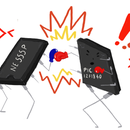Introduction: Bicycle Chain Tensioner for Off-Road Ebike
As a departure from my usual electronics Instructables I decided to share a simple project where I made a chain tensioner for my fast off-road ebike. I built my ebike 10-years ago and it's still going strong but I don't really use the gears so I decided to make it fixed speed and remove all the derailleurs that just rattle and bounce as I'm riding on rough dirt tracks. The only real downside being that the now absent rear derailleur provided the chain tension.
I didn't really intend on making a chain tensioner and would have been perfectly happy to buy an off-the-shelf solution but I couldn't find anything suitable so I decided to fire up Fusion360, dust down the 3D printer and nip over to Norwich hackspace to jump on the laser cutter.
The result was a really simple chain tensioner that you could build in a few hours over the weekend which you could adapt for any machine with a chain drive.
Supplies
Here's a list of all the materials I used.
- 24mm x 40mm U-bolts x 2 (24mm is the inner diameter)
- M6 x 40 bolt (for axle)
- M6 Penny Washers x 4
- M6 Standard Washers x 4
- M6 Locknuts x 6
- 6mm Laser Acrylic (or similar)
- PLA for 3D printer (or similar)
And here's a list of the tools I used.
- 3D Printer
- Laser Cutter
- 10mm Spanner
Step 1: Roller
As with most of my 3D printed project designs, I used Fusion360 to design the chain roller. I simply measured a bike chain and made the dimension between the rollers slightly wider at 9mm. I knew I wanted to use a 6mm bolt to mount the roller so I made the hole through the roller 6.5mm (3D printers usually shrink so I guessed this would be fine). The outer flanges have a diameter of 22mm and the roller has an inner diameter of 12mm.
Once the roller was designed I used Fusion360 to export the design as a .stl file which I sliced using cura. I used a 50% infill and standard quality to print the roller. I printed it on my Ender3 Pro with standard PLA.
I have attached the .stl file if you want to use it.
Attachments
Step 2: Bracket
The part of the bike frame that runs parallel to the chain is called the chain stay and this is what I used to bolt my chain tensioner to.
Before I started designing the tensioner bracket I measured the diameter of the chain stay frame and the distance the chain sits below the chain stay.
The chain stay on my bike is about 22mm diameter so I used 24mm inside diameter M6 U-Bolts to bolt the tensioner bracket in place. I wanted the chain tensioner to be adjustable so I designed the roller height to be adjustable with a slot.
The chain on my bike hangs about 90mm below the chain stay so this determines the the vertical length of the bracket.
I designed the bracket using a 2D CAD program and saved it as a .dxf file to export to lightburn so that I could cut the bracket out of 6mm acrylic at my local Hackspace.
I've attached the .dxf file if you want to use it.
Attachments
Step 3: Assembly
To fit the chain tensioner to the bike follow these steps:
- Put the U-bolts in position on the chain stay.
- Mount the tensioner bracket on the U-bolts with the slot pointing downwards.
- The 4 standard M6 washers over the U-bolt threads.
- Secure the bracket in place with 4 M6 locknuts and tighten evenly.
- Put an M6 penny washer on the M6 bolt.
- Place the M6 bolt through the bracket slot pointing towards the wheel.
- Put another M6 penny washer on the M6 bolt so the bracket is sandwiched between the two penny washers.
- Thread an M6 Locknut onto the M6 bolt and thread down until it touches the M6 penny washer but not tight.
- Place another M6 penny washer onto the bolt.
- Place the roller onto the bolt.
- Place another M6 penny washer onto the bolt.
- Move the bolt up the bracket slot so that the chain is tightened enough.
- Tighten the axle to the bracket with the first M6 bolt.
- Check everything is running fine and adjust as required.
I've attached a video of the assembled unit which should help with the assembly.
Step 4: Testing
I took the bike for a long ride over rough dirt tracks once complete and it all worked fine. I will be interested how long everything lasts and whether I need to build a more robust version out of metal but for now it all seems to be holding up fine.






